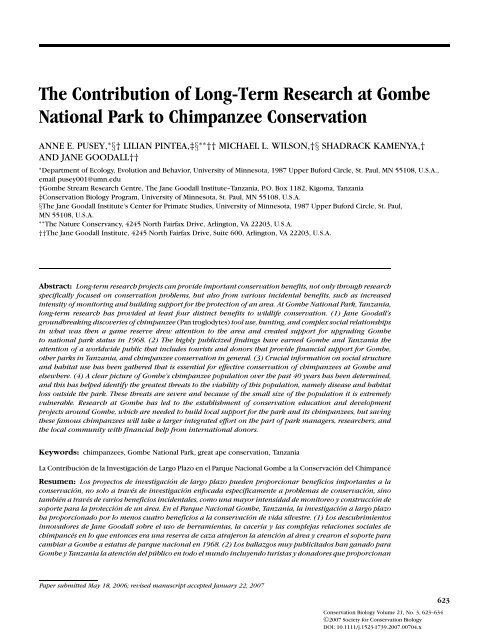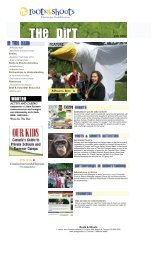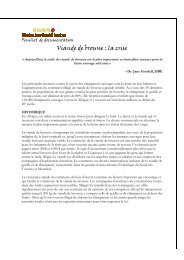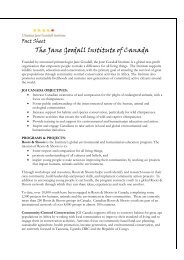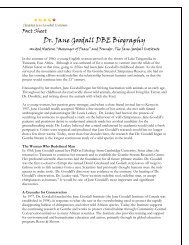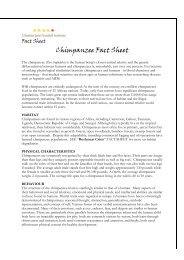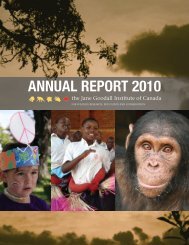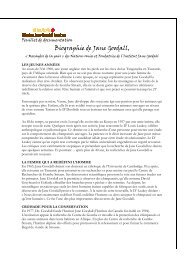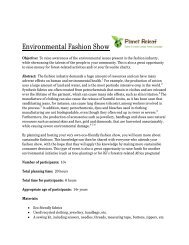The Contribution of Long-Term Research at Gombe National Park to ...
The Contribution of Long-Term Research at Gombe National Park to ...
The Contribution of Long-Term Research at Gombe National Park to ...
Create successful ePaper yourself
Turn your PDF publications into a flip-book with our unique Google optimized e-Paper software.
<strong>The</strong> <strong>Contribution</strong> <strong>of</strong> <strong>Long</strong>-<strong>Term</strong> <strong>Research</strong> <strong>at</strong> <strong>Gombe</strong>N<strong>at</strong>ional <strong>Park</strong> <strong>to</strong> Chimpanzee Conserv<strong>at</strong>ionANNE E. PUSEY, ∗ §† LILIAN PINTEA,‡§ ∗∗ †† MICHAEL L. WILSON,†§ SHADRACK KAMENYA,†AND JANE GOODALL††∗ Department <strong>of</strong> Ecology, Evolution and Behavior, University <strong>of</strong> Minnesota, 1987 Upper Buford Circle, St. Paul, MN 55108, U.S.A.,email pusey001@umn.edu†<strong>Gombe</strong> Stream <strong>Research</strong> Centre, <strong>The</strong> Jane Goodall Institute–Tanzania, P.O. Box 1182, Kigoma, Tanzania‡Conserv<strong>at</strong>ion Biology Program, University <strong>of</strong> Minnesota, St. Paul, MN 55108, U.S.A.§<strong>The</strong> Jane Goodall Institute’s Center for Prim<strong>at</strong>e Studies, University <strong>of</strong> Minnesota, 1987 Upper Buford Circle, St. Paul,MN 55108, U.S.A.∗∗ <strong>The</strong> N<strong>at</strong>ure Conservancy, 4245 North Fairfax Drive, Arling<strong>to</strong>n, VA 22203, U.S.A.††<strong>The</strong> Jane Goodall Institute, 4245 North Fairfax Drive, Suite 600, Arling<strong>to</strong>n, VA 22203, U.S.A.Abstract: <strong>Long</strong>-term research projects can provide important conserv<strong>at</strong>ion benefits, not only through researchspecifically focused on conserv<strong>at</strong>ion problems, but also from various incidental benefits, such as increasedintensity <strong>of</strong> moni<strong>to</strong>ring and building support for the protection <strong>of</strong> an area. At <strong>Gombe</strong> N<strong>at</strong>ional <strong>Park</strong>, Tanzania,long-term research has provided <strong>at</strong> least four distinct benefits <strong>to</strong> wildlife conserv<strong>at</strong>ion. (1) Jane Goodall’sgroundbreaking discoveries <strong>of</strong> chimpanzee (Pan troglodytes) <strong>to</strong>ol use, hunting, and complex social rel<strong>at</strong>ionshipsin wh<strong>at</strong> was then a game reserve drew <strong>at</strong>tention <strong>to</strong> the area and cre<strong>at</strong>ed support for upgrading <strong>Gombe</strong><strong>to</strong> n<strong>at</strong>ional park st<strong>at</strong>us in 1968. (2) <strong>The</strong> highly publicized findings have earned <strong>Gombe</strong> and Tanzania the<strong>at</strong>tention <strong>of</strong> a worldwide public th<strong>at</strong> includes <strong>to</strong>urists and donors th<strong>at</strong> provide financial support for <strong>Gombe</strong>,other parks in Tanzania, and chimpanzee conserv<strong>at</strong>ion in general. (3) Crucial inform<strong>at</strong>ion on social structureand habit<strong>at</strong> use has been g<strong>at</strong>hered th<strong>at</strong> is essential for effective conserv<strong>at</strong>ion <strong>of</strong> chimpanzees <strong>at</strong> <strong>Gombe</strong> andelsewhere. (4) A clear picture <strong>of</strong> <strong>Gombe</strong>’s chimpanzee popul<strong>at</strong>ion over the past 40 years has been determined,and this has helped identify the gre<strong>at</strong>est thre<strong>at</strong>s <strong>to</strong> the viability <strong>of</strong> this popul<strong>at</strong>ion, namely disease and habit<strong>at</strong>loss outside the park. <strong>The</strong>se thre<strong>at</strong>s are severe and because <strong>of</strong> the small size <strong>of</strong> the popul<strong>at</strong>ion it is extremelyvulnerable. <strong>Research</strong> <strong>at</strong> <strong>Gombe</strong> has led <strong>to</strong> the establishment <strong>of</strong> conserv<strong>at</strong>ion educ<strong>at</strong>ion and developmentprojects around <strong>Gombe</strong>, which are needed <strong>to</strong> build local support for the park and its chimpanzees, but savingthese famous chimpanzees will take a larger integr<strong>at</strong>ed effort on the part <strong>of</strong> park managers, researchers, andthe local community with financial help from intern<strong>at</strong>ional donors.Keywords: chimpanzees, <strong>Gombe</strong> N<strong>at</strong>ional <strong>Park</strong>, gre<strong>at</strong> ape conserv<strong>at</strong>ion, TanzaniaLa Contribución de la Investigación de Largo Plazo en el Parque Nacional <strong>Gombe</strong> a la Conservación del ChimpancéResumen: Los proyec<strong>to</strong>s de investigación de largo plazo pueden proporcionar beneficios importantes a laconservación, no solo a través de investigación enfocada específicamente a problemas de conservación, sinotambién a través de varios beneficios incidentales, como una mayor intensidad de moni<strong>to</strong>reo y construcción desoporte para la protección de un área. En el Parque Nacional <strong>Gombe</strong>, Tanzania, la investigación a largo plazoha proporcionado por lo menos cu<strong>at</strong>ro beneficios a la conservación de vida silvestre. (1) Los descubrimien<strong>to</strong>sinnovadores de Jane Goodall sobre el uso de herramientas, la cacería y las complejas relaciones sociales dechimpancés en lo que en<strong>to</strong>nces era una reserva de caza <strong>at</strong>rajeron la <strong>at</strong>ención al área y crearon el soporte paracambiar a <strong>Gombe</strong> a est<strong>at</strong>us de parque nacional en 1968. (2) Los hallazgos muy publicitados han ganado para<strong>Gombe</strong> y Tanzania la <strong>at</strong>ención del público en <strong>to</strong>do el mundo incluyendo turistas y donadores que proporcionanPaper submitted May 18, 2006; revised manuscript accepted January 22, 2007Conserv<strong>at</strong>ion Biology Volume 21, No. 3, 623–634C○2007 Society for Conserv<strong>at</strong>ion BiologyDOI: 10.1111/j.1523-1739.2007.00704.x623
624 <strong>Long</strong>-<strong>Term</strong> Chimpanzee <strong>Research</strong> Pusey et al.soporte financiero a <strong>Gombe</strong>, otros parques en Tanzania y a la conservación de chimpancés en general. (3)Se ha reunido información crucial sobre la estructura social y el uso del hábit<strong>at</strong> que ha sido esencial parala conservación efectiva de chimpancés en <strong>Gombe</strong> y otros sitios. (4) Se ha determinado un panorama clarode la población de chimpancés en <strong>Gombe</strong> durante los últimos 40 años, y es<strong>to</strong> ha ayudado a identificar lasmayores amenazas a la viabilidad de esta población, a saber enfermedades y pérdida de hábit<strong>at</strong> fuera delparque. Estas amenazas son severas y la población es extremadamente vulnerable por su tamaño pequeño.La investigación en <strong>Gombe</strong> ha llevado al establecimien<strong>to</strong> de proyec<strong>to</strong>s de desarrollo y de educación para laconservación en los alrededores del parque, lo cual es necesario para encontrar soporte local para el parque ysus chimpancés, pero el resc<strong>at</strong>e de es<strong>to</strong>s famosos chimpancés requerirá de un esfuerzo más integrado de partede los manejadores del parque, investigadores y la comunidad local con la ayuda financiera de donadoresinternacionales.Palabras Clave:chimpancé, conservación de simios mayores, Parque Nacional <strong>Gombe</strong>, TanzaniaIntroduction<strong>The</strong> gre<strong>at</strong> apes—our closest living rel<strong>at</strong>ives—have <strong>at</strong>tractedintense interest from the general public and fromresearchers, especially those seeking <strong>to</strong> understand theorigins and evolution <strong>of</strong> our own species. Despite thisinterest, their existence is thre<strong>at</strong>ened. Even chimpanzees(Pan troglodytes), the most abundant, widespread, andintensively studied <strong>of</strong> the gre<strong>at</strong> apes are <strong>at</strong> risk. Chimpanzeesare believed <strong>to</strong> have declined from perhaps 1million in 1900 (Teleki 1989) <strong>to</strong> an estim<strong>at</strong>ed 172,200–299,700 in 2000 (Butynski 2003) and are now listed as anendangered species. Although the <strong>to</strong>tal popul<strong>at</strong>ion size<strong>of</strong> chimpanzees is large compared with some criticallyendangered species, such as Sum<strong>at</strong>ran orangutans (O<strong>at</strong>es2006), chimpanzees reproduce and m<strong>at</strong>ure slowly, makingthem vulnerable <strong>to</strong> increased mortality from huntingand disease (Butynski 2001). <strong>The</strong> majority <strong>of</strong> chimpanzeeslive in the Congo basin, a region where armedconflicts cre<strong>at</strong>e severe difficulties for wildlife protection.Clearing <strong>of</strong> forests for timber and agriculture is increasinglyleaving chimpanzees in isol<strong>at</strong>ed, small popul<strong>at</strong>ionsth<strong>at</strong> face edge effects, genetic isol<strong>at</strong>ion, and elev<strong>at</strong>ed risk<strong>of</strong> extinction (Hill et al. 2001). Even in regions withlarge expanses <strong>of</strong> intact forest, chimpanzees have suffereddram<strong>at</strong>ic declines, due in part <strong>to</strong> disease (Walsh et al.2003).<strong>Long</strong>-term research has an important role <strong>to</strong> play inchimpanzee conserv<strong>at</strong>ion. At the intern<strong>at</strong>ional level researchershave alerted the global community <strong>to</strong> the crisisfacing chimpanzees and other apes (e.g., Peterson &Goodall 1993; Wrangham 2000; Walsh et al. 2003). At thelocal level the mere presence <strong>of</strong> researchers provides importantconserv<strong>at</strong>ion benefits because they “keep moni<strong>to</strong>rsin the field and enlarge the constituency <strong>of</strong> interestand support” (Wrangham 2000: 448). <strong>Research</strong> can promotepositive <strong>at</strong>titudes <strong>to</strong>ward protected areas by providingemployment for local people and permit fees andother income <strong>at</strong> the n<strong>at</strong>ional level. <strong>Long</strong>-term studies canalso contribute needed baseline d<strong>at</strong>a for planning, moni<strong>to</strong>ring,and evalu<strong>at</strong>ion <strong>of</strong> conserv<strong>at</strong>ion projects (Chapman& Peres 2001). If researchers make the appropri<strong>at</strong>eefforts, they can also increase their awareness <strong>of</strong> andinvolvement in conserv<strong>at</strong>ion decision-making processes,providing scientific guidance and inform<strong>at</strong>ion for managementdecisions. We report the experience <strong>of</strong> <strong>Gombe</strong>,the first park cre<strong>at</strong>ed <strong>to</strong> protect chimpanzees and discusshow research there has contributed <strong>to</strong> conserv<strong>at</strong>ion theoryand practice <strong>at</strong> the intern<strong>at</strong>ional, n<strong>at</strong>ional, and localscales.<strong>Gombe</strong> N<strong>at</strong>ional <strong>Park</strong><strong>Gombe</strong> N<strong>at</strong>ional <strong>Park</strong> (GNP) is in the Kigoma Region <strong>of</strong>northwestern Tanzania (Fig. 1). <strong>The</strong> park is a narrow strip<strong>of</strong> mountainous landscape covering 35 km 2 . A series <strong>of</strong>steep-sided valleys fall from the rift escarpment <strong>to</strong> LakeTanganyika, with evergreen and semideciduous forest onthe lower slopes and a mosaic <strong>of</strong> thicket, woodland, andgrassland on the upper slopes (Goodall 1986). Althoughsmall, the park is rich in biodiversity, with elements <strong>of</strong>western Guinea-Congolean and Afromontane forests andZambesian miombo woodlands (Clut<strong>to</strong>n-Brock & Gillett1979).As early as the 1940s, deforest<strong>at</strong>ion fueled by growinghuman popul<strong>at</strong>ions thre<strong>at</strong>ened this area (Moreau 1945).To protect the chimpanzees, the colonial government established<strong>Gombe</strong> Stream Game Reserve in January 1943(Government Notice 46), adding a small extension in1955 (Government Notice 95; Thomas 1961). Althoughwe could not find document<strong>at</strong>ion <strong>of</strong> the precise extent<strong>of</strong> the original reserve, one <strong>of</strong> us ( J.G.) remembers th<strong>at</strong>it originally extended some distance <strong>to</strong> the east <strong>of</strong> therift escarpment but was effectively reduced in size whena warden mis<strong>to</strong>ok survey beacons along the <strong>to</strong>p <strong>of</strong> theridge for the markings <strong>of</strong> the reserve boundary. This errorhas had grave consequences for the viability <strong>of</strong> <strong>Gombe</strong>’schimpanzee popul<strong>at</strong>ion.Conserv<strong>at</strong>ion BiologyVolume 21, No. 3, June 2007
Pusey et al. <strong>Long</strong>-<strong>Term</strong> Chimpanzee <strong>Research</strong> 625Figure 1. <strong>Gombe</strong> N<strong>at</strong>ional<strong>Park</strong> in Tanzania. <strong>Park</strong>boundary, research andadministr<strong>at</strong>ive settlements(triangles), streams, villages(circles), and major roadsare deline<strong>at</strong>ed.Jane Goodall began studying the chimpanzees <strong>of</strong> the<strong>Gombe</strong> Stream Game Reserve in 1960. At th<strong>at</strong> time littlewas known <strong>of</strong> the n<strong>at</strong>ural behavior and social structure<strong>of</strong> wild chimpanzees. In the first year <strong>of</strong> her study shemade landmark discoveries—th<strong>at</strong> chimpanzees make anduse <strong>to</strong>ols (Goodall 1964) and hunt and e<strong>at</strong> me<strong>at</strong> (Goodall1963a). <strong>The</strong>se and subsequent discoveries were publicizedin N<strong>at</strong>ional Geographic articles and films. <strong>The</strong> resultingintern<strong>at</strong>ional <strong>at</strong>tention prompted Tanzania’s firstpresident, Julius Nyerere, <strong>to</strong> declare <strong>Gombe</strong> a n<strong>at</strong>ionalpark in 1968 (Government Notice 234). Goodall and herresearch team have continued the chimpanzee study formore than 45 years, and other species such as baboonsand red colobus have also been studied (e.g., Clut<strong>to</strong>n-Brock 1973; Ransom 1981; Packer et al. 1998; Stanford1998), resulting in 35 Ph.D. theses, over 400 papers, andmore than 30 books.<strong>Contribution</strong>s <strong>of</strong> the <strong>Long</strong>-<strong>Term</strong> Study <strong>to</strong>Conserv<strong>at</strong>ion in General<strong>The</strong> discoveries about chimpanzee behavior from thelong-term <strong>Gombe</strong> study excited tremendous interest and<strong>at</strong>tention in the scientific community, and, through popularmedia, <strong>Gombe</strong> has reached a global audience (Goodall1963b, 1971, 2003; Goodall & Berman 1999; ScienceNorth 2002). Beginning in the 1980s, Goodall used thefame derived from her <strong>Gombe</strong> studies <strong>to</strong> advoc<strong>at</strong>e worldwidefor the conserv<strong>at</strong>ion and welfare <strong>of</strong> chimpanzeesand for stewardship <strong>of</strong> the Earth (e.g., Goodall & Berman1999; Goodall & Bek<strong>of</strong>f 2002). <strong>The</strong> Jane Goodall Institute( JGI), founded in 1977, supports wildlife research,conserv<strong>at</strong>ion, and educ<strong>at</strong>ion. JGI is working in six chimpanzeerange countries in Africa and has <strong>of</strong>fices in 18countries worldwide. <strong>The</strong> institute’s Roots & Shoots pro-Conserv<strong>at</strong>ion BiologyVolume 21, No. 3, June 2007
626 <strong>Long</strong>-<strong>Term</strong> Chimpanzee <strong>Research</strong> Pusey et al.gram is one <strong>of</strong> the fastest growing environmental educ<strong>at</strong>ionprograms for youth with over 8000 active groups in97 countries (www.janegoodall.org).Many researchers who trained <strong>at</strong> <strong>Gombe</strong> now work <strong>at</strong>other field sites, where they have promoted conserv<strong>at</strong>ion<strong>at</strong> local and intern<strong>at</strong>ional levels (e.g., Packer et al. 1999;Stanford 2001; Wrangham 2000; Tutin et al. 2001). Otherfield sites have been founded by researchers who describethemselves as inspired and influenced by <strong>Gombe</strong> research(e.g., Ghiglieri 1988; Boesch & Boesch-Achermann 2000).<strong>The</strong> fame <strong>of</strong> the study <strong>at</strong>tracts <strong>to</strong>urists <strong>to</strong> <strong>Gombe</strong>, despiteits remote loc<strong>at</strong>ion, far from Tanzania’s main wildlife<strong>to</strong>urism circuit. Although <strong>to</strong>urism may present risks <strong>to</strong> prim<strong>at</strong>ehealth (Butynski & Kalina 1998), <strong>to</strong>urists help payfor conserv<strong>at</strong>ion <strong>at</strong> <strong>Gombe</strong> and by visiting other parkssupport conserv<strong>at</strong>ion across Tanzania.Understanding ChimpanzeesSocial StructureBecause <strong>of</strong> chimpanzees’ longevity (over 60 years in captivity),slow m<strong>at</strong>ur<strong>at</strong>ion (first birth <strong>at</strong> 11–14 years), largerange areas, and dispersed societies, it <strong>to</strong>ok many yearsfor scientists <strong>to</strong> understand their basic social structure,including rel<strong>at</strong>ionships among individuals within groupsand the p<strong>at</strong>terns <strong>of</strong> transfer among groups. Nonetheless,from long-term observ<strong>at</strong>ions <strong>of</strong> individually recognizedchimpanzees <strong>at</strong> two principal study sites—<strong>Gombe</strong> (startingin 1960) and Mahale, 160 km <strong>to</strong> the south on LakeTanganyika (starting in 1966)—a picture <strong>of</strong> chimpanzeesociety gradually emerged (Goodall 1986; Nishida 1990).This picture has subsequently been confirmed and expandedupon by studies <strong>at</strong> other sites across Africa (Mitaniet al. 2002).Goodall initially believed chimpanzees lived in looselyorganized “communities” in which individuals <strong>of</strong> bothsexes moved freely across the landscape, with popul<strong>at</strong>ionssepar<strong>at</strong>ed only by geographical barriers (van Lawick-Goodall 1968). <strong>The</strong> existence <strong>of</strong> distinct, mutually hostilesocial groups (“unit-groups”) was first documented <strong>at</strong> Mahale(Nishida 1968). Goodall eventually documented theexistence <strong>of</strong> equivalent social groups <strong>at</strong> <strong>Gombe</strong> (Goodall1973), but continued <strong>to</strong> use the term community r<strong>at</strong>herthan unit-group, as have most Anglophone researchers.All members <strong>of</strong> a community rarely or never come <strong>to</strong>gether<strong>at</strong> once. Instead, chimpanzees spend their timein subgroups called parties th<strong>at</strong> vary in size and composition,with males being more gregarious than females(Nishida 1968). Males cooper<strong>at</strong>e <strong>to</strong> p<strong>at</strong>rol their terri<strong>to</strong>ryand occasionally <strong>at</strong>tack and kill individuals from othercommunities (Goodall et al. 1979). A series <strong>of</strong> such intergroupkillings resulted in the extinction <strong>of</strong> the Kahamacommunity <strong>at</strong> <strong>Gombe</strong> (Goodall 1986). More intergroupkillings have been observed recently (Wilson et al. 2004).Lethal intergroup <strong>at</strong>tacks have been observed in the majority<strong>of</strong> long-term study popul<strong>at</strong>ions (Wilson & Wrangham2003). After disease, intergroup aggression is theleading cause <strong>of</strong> de<strong>at</strong>h for <strong>Gombe</strong> chimpanzees (<strong>Gombe</strong>Stream <strong>Research</strong> Centre, unpublished d<strong>at</strong>a).Analysis <strong>of</strong> long-term demographic records <strong>of</strong> knownindividuals <strong>at</strong> <strong>Gombe</strong> and Mahale shows th<strong>at</strong> males remainin the community in which they are born and th<strong>at</strong>most females leave their n<strong>at</strong>al community and join a newone before breeding (Nishida & Kawanaka 1972; Nishida1979; Pusey 1979). <strong>Research</strong> <strong>at</strong> other sites has confirmedth<strong>at</strong> this p<strong>at</strong>tern <strong>of</strong> male philop<strong>at</strong>ry and female dispersalis typical <strong>of</strong> the species (Mitani et al. 2002). <strong>The</strong> combin<strong>at</strong>ion<strong>of</strong> intergroup hostility and male philop<strong>at</strong>ry has twoimplic<strong>at</strong>ions for conserv<strong>at</strong>ion. First, if neighboring communitiesbecome unequal in size, the smaller communityis <strong>at</strong> risk <strong>of</strong> being extermin<strong>at</strong>ed by its larger neighbor(s).Second, this intense hostility <strong>to</strong>ward foreign chimpanzeescomplic<strong>at</strong>es efforts <strong>to</strong> reintroduce captive chimpanzees<strong>to</strong> the wild. Males <strong>of</strong> any age, and infants <strong>of</strong> either sex,face a serious risk <strong>of</strong> being <strong>at</strong>tacked and killed if releasedin<strong>to</strong> areas with wild chimpanzees (Goossens et al. 2005).Habit<strong>at</strong> RequirementsWhen <strong>Gombe</strong> was first established as a reserve, the amount<strong>of</strong> land and type <strong>of</strong> habit<strong>at</strong> needed for a viable chimpanzeepopul<strong>at</strong>ion was entirely a m<strong>at</strong>ter <strong>of</strong> guesswork.<strong>Research</strong> <strong>at</strong> <strong>Gombe</strong> and other sites has since produceddetailed inform<strong>at</strong>ion on diet and range use. Chimpanzeeslive in a variety <strong>of</strong> habit<strong>at</strong>s, from savanna woodlands andwoodland-dry forest mosaics <strong>to</strong> rain forests (Teleki 1989).<strong>The</strong>y feed mainly on ripe fruit, but they also e<strong>at</strong> leaves,other plant parts, insects, and hunt monkeys and othermammals (Nishida et al. 1983). Because chimpanzees requireripe fruit, their ranges always include some proportion<strong>of</strong> evergreen or riverine forest, even when livingin semiarid regions. Because their food resources arep<strong>at</strong>chy and widely dispersed, chimpanzees require largehome ranges, on the order <strong>of</strong> 5–20 km 2 /community in<strong>Gombe</strong> (Pusey et al. 2005) and up <strong>to</strong> 30–40 km 2 in otherforest sites (Wilson & Wrangham 2003). Chimpanzeesliving in drier habit<strong>at</strong>s with more sp<strong>at</strong>ially and temporallysc<strong>at</strong>tered food resources require much larger homeranges (Baldwin et al. 1982). Recent GIS and remotesensingapplic<strong>at</strong>ions <strong>of</strong>fer new ways <strong>of</strong> understandingthe roles <strong>of</strong> veget<strong>at</strong>ion types, <strong>to</strong>pography, and other habit<strong>at</strong>characteristics—such as distance from neighboringcommunities—on ranging and behavior. This new knowledge<strong>of</strong> chimpanzee habit<strong>at</strong> use gained from <strong>Gombe</strong> andother sites can provide critical inform<strong>at</strong>ion for better design<strong>of</strong> new protected areas (Pintea 2007).Conserv<strong>at</strong>ion BiologyVolume 21, No. 3, June 2007
Pusey et al. <strong>Long</strong>-<strong>Term</strong> Chimpanzee <strong>Research</strong> 627Identifying Thre<strong>at</strong>s <strong>to</strong> <strong>Gombe</strong> ChimpanzeesDemographic P<strong>at</strong>terns<strong>The</strong> detailed demographic d<strong>at</strong>a obtained <strong>at</strong> <strong>Gombe</strong> overthe past 40 years had enabled the examin<strong>at</strong>ion <strong>of</strong> popul<strong>at</strong>iontrends and identific<strong>at</strong>ion <strong>of</strong> specific thre<strong>at</strong>s facingthis small popul<strong>at</strong>ion <strong>of</strong> chimpanzees. <strong>Gombe</strong> currentlycontains three communities: Mitumba, Kasekela, and Kalande(Fig. 2). <strong>The</strong> Kasekela community has been studiedsince 1960, with all individuals recognized by 1966. Efforts<strong>to</strong> habitu<strong>at</strong>e the Mitumba community began in themid-1980s, with most individuals recognized by 1993. Seriousefforts <strong>to</strong> census the Kalande community began inthe l<strong>at</strong>e 1990s (Greengrass 2000a). This community remainslargely unhabitu<strong>at</strong>ed, with the precise number <strong>of</strong>individuals unknown. Although accur<strong>at</strong>e estim<strong>at</strong>es <strong>of</strong> thesize <strong>of</strong> the Mitumba and Kalande communities are notavailable before the 1990s, minimum and maximum estim<strong>at</strong>escan be made, based on occasional sightings inearlier years.Based on these estim<strong>at</strong>es, <strong>Gombe</strong>’s chimpanzee popul<strong>at</strong>ionhas declined since the 1960s (Fig. 3a). Consideringonly minimum estim<strong>at</strong>es, the popul<strong>at</strong>ion has declined <strong>at</strong>the r<strong>at</strong>e <strong>of</strong> 0.56 chimpanzees per year since 1964 (r 2 =0.62, p < 0.0001). It should be noted, however, th<strong>at</strong> theextent <strong>of</strong> the decline depends gre<strong>at</strong>ly on the estim<strong>at</strong>edsizes <strong>of</strong> the unhabitu<strong>at</strong>ed communities. During the yearswith reasonably accur<strong>at</strong>e d<strong>at</strong>a on all communities in thepark (1996–present), the overall popul<strong>at</strong>ion has remainedstable, but the p<strong>at</strong>tern <strong>of</strong> popul<strong>at</strong>ion change has variedconsiderably among the different communities (Fig. 3b).In 1972 the main study community was divided in<strong>to</strong> theKasekela and Kahama communities. Kasekela males thenkilled <strong>at</strong> least six members <strong>of</strong> the Kahama community,leading <strong>to</strong> its extinction in 1977 (Goodall 1986). Overthe years, the Kasekela popul<strong>at</strong>ion has ranged from 38<strong>to</strong> 69 individuals. <strong>The</strong> community suffered a c<strong>at</strong>astrophicdrop in numbers from 57 in 1986 <strong>to</strong> 40 in 1988, largelyfrom respir<strong>at</strong>ory disease. Since then, the community hasincreased in size, both from a large number <strong>of</strong> new birthsand from extensive immigr<strong>at</strong>ion from the declining Kalandecommunity.<strong>The</strong> Mitumba community experienced a steep declinedue <strong>to</strong> respir<strong>at</strong>ory disease in 1996 (Wallis & Lee 1999),but has since remained stable. <strong>The</strong> Kalande communitydeclined from approxim<strong>at</strong>ely 30 individuals in 1998 <strong>to</strong>perhaps 9 by mid-2006 (Greengrass 2000a, 2000b; <strong>Gombe</strong>Stream <strong>Research</strong> Centre, unpublished d<strong>at</strong>a). Over a 10-year period (1998–2006), <strong>at</strong> least 15 individuals emigr<strong>at</strong>edfrom Kalande <strong>to</strong> Kasekela. Although many <strong>of</strong> these wereFigure 2. Chimpanzee communityhome ranges in 1973 and 2004.Woodland and forest area converted<strong>to</strong> grassland or farmland areestim<strong>at</strong>ed from 1972 Lands<strong>at</strong> MSSand 1999 Lands<strong>at</strong> ETM+ s<strong>at</strong>elliteimages (Pintea 2007). <strong>The</strong> 1973Kasekela and Kahama ranges areminimum convex polygons th<strong>at</strong>encompass 99% <strong>of</strong> all loc<strong>at</strong>ionpoints recorded in 1973 (Williams etal. 2002). <strong>The</strong> 1973 Mitumba andKalande ranges are estim<strong>at</strong>es basedon incidental observ<strong>at</strong>ions insideand outside the park. <strong>The</strong> existenceand loc<strong>at</strong>ion <strong>of</strong> the Rift communityis based on a small number <strong>of</strong>sightings and the assumption th<strong>at</strong>there was a community east <strong>of</strong> theRift in the 1960s. <strong>The</strong> 2004 Kasekelaand Mitumba community rangesare based on 99% minimum convexpolygons enclosing 2004 loc<strong>at</strong>ionpoints. <strong>The</strong> 2004 Kalandecommunity range is estim<strong>at</strong>ed fromregular sightings.Conserv<strong>at</strong>ion BiologyVolume 21, No. 3, June 2007
628 <strong>Long</strong>-<strong>Term</strong> Chimpanzee <strong>Research</strong> Pusey et al.(polio, respir<strong>at</strong>ory disease, intestinal parasites) or fromdomestic<strong>at</strong>ed animals (mange).Figure 3. (a) Minimum and maximum estim<strong>at</strong>es <strong>of</strong>the number <strong>of</strong> chimpanzees in the <strong>to</strong>tal popul<strong>at</strong>ion.(b) Minimum numbers in each community over time.Estim<strong>at</strong>es for Mitumba and Kalande are highlyuncertain before about 1995. Kalande numbers arebased on the number <strong>of</strong> individuals known <strong>to</strong> be alivecurrently, plus the immigrants <strong>to</strong> Kasekela and thenumber <strong>of</strong> bodies found dead from disease, intergroupaggression, and poaching.adolescent females th<strong>at</strong> probably would have immigr<strong>at</strong>edin any case, others, particularly three mothers with dependent<strong>of</strong>fspring, probably would have remained in Kalandehad the community not lost most <strong>of</strong> its adult males,as happened during the decline <strong>of</strong> K-group in Mahale(Nishida et al. 1985). <strong>The</strong> Kasekela community currentlyincludes 62–69 individuals and the Kalande community8–15 individuals, depending on the st<strong>at</strong>us <strong>of</strong> seven recentlyidentified individuals th<strong>at</strong> may be moving betweenthe two communities.Causes <strong>of</strong> Demographic ChangesDiseaseAs <strong>at</strong> other sites, such as Mahale (Nishida et al. 2003) andTaï (Boesch & Boesch-Achermann 2000), disease is themain cause <strong>of</strong> de<strong>at</strong>h for <strong>Gombe</strong> chimpanzees (Goodall1983; Goodall 1986; Lonsdorf et al. 2006). It is likely th<strong>at</strong>some <strong>of</strong> these diseases are anthropogenic in origin (Leendertzet al. 2006), coming either directly from humansPoachingIn much <strong>of</strong> Africa illegal hunting presents the gre<strong>at</strong>estthre<strong>at</strong> <strong>to</strong> chimpanzee popul<strong>at</strong>ions. Until recently poachingwas not considered a problem around <strong>Gombe</strong>. <strong>Research</strong>ersrecorded only one case <strong>of</strong> a chimpanzee beingkilled by poachers in the first 35 years <strong>of</strong> the study(Goodall 1990). In more recent years (1998–2002) ninechimpanzees from the park are known or suspected<strong>to</strong> have been killed by poachers (Greengrass 2000a,2000b; <strong>Gombe</strong> Stream <strong>Research</strong> Centre, unpublishedd<strong>at</strong>a). Three males from the Mitumba community left thepark <strong>to</strong> the north, and the rumor was th<strong>at</strong> local peoplekilled them. <strong>The</strong> body <strong>of</strong> one adult male <strong>of</strong> the Kalandecommunity was found in the park with its genitals andhands cut <strong>of</strong>f. <strong>The</strong> decomposing body <strong>of</strong> a female wasfound in Kalande <strong>at</strong> the same time Congolese people approachedexp<strong>at</strong>ri<strong>at</strong>es in Kigoma with <strong>of</strong>fers <strong>of</strong> an infantchimpanzee for sale. <strong>The</strong> body <strong>of</strong> an adult male th<strong>at</strong> hadresided on village lands just <strong>to</strong> the east <strong>of</strong> Kalande wasfound inside the park with machete cuts. Finally, a reportwas heard <strong>of</strong> two females found dead in their nests in avalley just south <strong>of</strong> the park, although this case was notconfirmed and the cause <strong>of</strong> de<strong>at</strong>h was not established.<strong>The</strong>se must have origin<strong>at</strong>ed from the Kalande community.In recent years other evidence <strong>of</strong> poaching withinthe park includes observ<strong>at</strong>ions <strong>of</strong> snares, men with spearsand hunting dogs, and occasional incidences <strong>of</strong> semiau<strong>to</strong>m<strong>at</strong>icrifle fire (Greengrass 2000a). Although me<strong>at</strong> poachingis probably aimed <strong>at</strong> other species, there have beenthree cases <strong>of</strong> chimpanzees with snare wounds and twochimpanzees with spear wounds (F. Grossman, unpublishedd<strong>at</strong>a). It is possible th<strong>at</strong> poaching occurred previouslybut was undetected due <strong>to</strong> the lack <strong>of</strong> researchactivity in the northern and southern ends <strong>of</strong> the park.Intercommunity AggressionObserv<strong>at</strong>ions from <strong>Gombe</strong> suggest th<strong>at</strong> communities living<strong>at</strong> the edge <strong>of</strong> protected areas face a higher risk <strong>of</strong>mortality from anthropogenic sources, such as diseaseand poaching, and from intergroup aggression (Wilsonet al. 2004). Communities th<strong>at</strong> have lost males <strong>to</strong> anthropogenicfac<strong>to</strong>rs are less able <strong>to</strong> defend themselves fromcommunities with many males, which are more likely<strong>to</strong> win fights, gain terri<strong>to</strong>ry (Fig. 2), and kill members<strong>of</strong> the smaller community (Wilson & Wrangham 2003).Chimpanzees living along park boundaries thus risk beingcaught in a slowly closing trap <strong>of</strong> habit<strong>at</strong> loss, disease, andpoaching on one side and increasing pressure from morepowerfulchimpanzee communities on the other side.Conserv<strong>at</strong>ion BiologyVolume 21, No. 3, June 2007
Pusey et al. <strong>Long</strong>-<strong>Term</strong> Chimpanzee <strong>Research</strong> 629Figure 4. (a) Map <strong>of</strong> the study area showing five 1-km buffers around the centers <strong>of</strong> each chimpanzee community.<strong>The</strong> centers <strong>of</strong> the Mitumba and Kasekela communities are the centers <strong>of</strong> the minimum convex polygons <strong>of</strong> their2004 ranges shown in Fig. 2. Areas outside the park within 1 km <strong>of</strong> villages along the lakeshore and major roadsare not considered chimpanzee habit<strong>at</strong> and have been excluded. (b) Changes in percentage <strong>of</strong> forest and woodlandcover between 1972 and 1999 in each buffer zone around each community (1–5 km outward; Pintea 2007).Habit<strong>at</strong> DisturbanceAlthough habit<strong>at</strong> within the park remains well protected,destruction <strong>of</strong> forest and woodlands outside the parkdriven by rapid popul<strong>at</strong>ion growth and immigr<strong>at</strong>ion <strong>of</strong>refugees fleeing wars in Burundi and Congo has had adevast<strong>at</strong>ing effect on the park’s chimpanzees. Changedetectionanalysis, conducted with normalized NDVI differencing<strong>of</strong> 1972 Lands<strong>at</strong> MSS and 1999 Lands<strong>at</strong> ETM+s<strong>at</strong>ellite imagery, indic<strong>at</strong>es th<strong>at</strong> forest and woodlandcover has increased inside the park but declined severelyoutside the park (Pintea 2007; Fig. 4). A complementarychange-detection analysis, conducted through postclassific<strong>at</strong>ion<strong>of</strong> 1972 Lands<strong>at</strong> MSS, 1991 SPOT-2, and 2003SPOT-4 s<strong>at</strong>ellite imagery, shows th<strong>at</strong> in 1972 there werestill large p<strong>at</strong>ches <strong>of</strong> forest and woodland adjacent <strong>to</strong> thepark similar in size and distribution <strong>to</strong> p<strong>at</strong>ches detectedfrom 1947 and 1956 aerial pho<strong>to</strong>s (Pintea 2007). By 199129% <strong>of</strong> the forest and woodland cover had been converted<strong>to</strong> farmlands, and by 2003 more than 50% <strong>of</strong> chimpanzeehabit<strong>at</strong> adjacent <strong>to</strong> GNP had been lost.Deforest<strong>at</strong>ion has had unequal effects on the threechimpanzee communities. <strong>The</strong> Kasekela chimpanzees, loc<strong>at</strong>edin the center <strong>of</strong> the park, have been least affected bydeforest<strong>at</strong>ion outside the park. In contrast, the Mitumbaand Kalande communities have likely lost key range areasConserv<strong>at</strong>ion BiologyVolume 21, No. 3, June 2007
630 <strong>Long</strong>-<strong>Term</strong> Chimpanzee <strong>Research</strong> Pusey et al.(Fig. 2). Habit<strong>at</strong> loss outside the park has probably beenmost devast<strong>at</strong>ing <strong>to</strong> the Kalande community. <strong>The</strong> Kalanderange is in the driest, narrowest part <strong>of</strong> the park, domin<strong>at</strong>edby miombo woodland veget<strong>at</strong>ion and heavily controlledby fires th<strong>at</strong> burn a major part <strong>of</strong> the range eachyear. Res<strong>to</strong>ring and protecting forest and woodland habit<strong>at</strong>soutside the park within the former his<strong>to</strong>rical rangewould gre<strong>at</strong>ly improve the viability <strong>of</strong> the Mitumba andKalande communities.Reducing the Thre<strong>at</strong>sPopul<strong>at</strong>ion Viability AnalysisD<strong>at</strong>a on demography and popul<strong>at</strong>ion thre<strong>at</strong>s have beenincorpor<strong>at</strong>ed in<strong>to</strong> a popul<strong>at</strong>ion viability analysis <strong>to</strong> determinethe likely future <strong>of</strong> this popul<strong>at</strong>ion and <strong>to</strong> identify interventionsmost likely <strong>to</strong> improve popul<strong>at</strong>ion viability ( J.Earnhardt et al., unpublished d<strong>at</strong>a). In 2000 iter<strong>at</strong>ions <strong>of</strong>the model, the <strong>Gombe</strong> chimpanzee popul<strong>at</strong>ion continued<strong>to</strong> decline, with a mean <strong>of</strong> 40 chimpanzees expected <strong>to</strong>remain 100 years from now. Unless something is done <strong>to</strong>reverse this decline, the popul<strong>at</strong>ion will become extincteventually. Results from running the model with differentscenarios suggest this decline could be reversed by thefollowing actions: increasing carrying capacity throughexpanding habit<strong>at</strong>, reducing mortality from disease andpoaching, and supplementing the popul<strong>at</strong>ion with reproductivefemales from other popul<strong>at</strong>ions (such as sanctuaries).Although none <strong>of</strong> these interventions is likely <strong>to</strong>be easy, the model makes clear th<strong>at</strong> appropri<strong>at</strong>e actiontaken now could ensure the long-term survival <strong>of</strong> thispopul<strong>at</strong>ion.DiseaseAlthough outbreaks <strong>of</strong> disease <strong>of</strong> possible anthropogenicorigin occurred in the <strong>Gombe</strong> chimpanzees in the firstdecade <strong>of</strong> the study, these have been sporadic and separ<strong>at</strong>edby many years <strong>of</strong> compar<strong>at</strong>ively good health. Ittherefore <strong>to</strong>ok researchers in <strong>Gombe</strong> and elsewhere along time <strong>to</strong> fully acknowledge the risks <strong>of</strong> disease transferfrom humans, and because <strong>of</strong> logistical difficultiesin diagnosis, the true origin and transmission <strong>of</strong> thesediseases are still unknown. In recent years researchershave led efforts <strong>to</strong> reduce the risk <strong>of</strong> disease transmissionfrom humans. Following a respir<strong>at</strong>ory outbreak in theKasekela community in 2000 th<strong>at</strong> resulted in two chimpanzeede<strong>at</strong>hs, researchers halted artificial provisioning<strong>of</strong> chimpanzees. Although provisioning <strong>at</strong> other sites waseither abandoned earlier (e.g., Mahale, in 1987 [Nishida1990]) or never used (Ghiglieri 1984; Boesch & Boesch-Achermann 2000), it was continued <strong>at</strong> <strong>Gombe</strong> because itfacilit<strong>at</strong>ed regular observ<strong>at</strong>ion <strong>of</strong> individuals, filming, theability <strong>to</strong> tre<strong>at</strong> certain diseases (Goodall 1983, 1986), measurement<strong>of</strong> body mass (Pusey et al. 2005), and <strong>to</strong>urism.<strong>The</strong> respir<strong>at</strong>ory outbreak <strong>of</strong> 2000 led <strong>to</strong> the implement<strong>at</strong>ion<strong>of</strong> a set <strong>of</strong> health guidelines for researchersand <strong>to</strong>urists, including quarantine periods, minimum distances,and limited periods with chimpanzees (Collins2003). <strong>Research</strong>ers introduced a shift system <strong>to</strong> reducethe number <strong>of</strong> people living in the park, built wire mesh“cages” <strong>at</strong> house entrances <strong>to</strong> prevent baboons and chimpanzeesfrom handling dishes, clothes, and other objectsand employed a sanit<strong>at</strong>ion guard <strong>to</strong> keep the staff quartersclean. <strong>Research</strong>ers also introduced a chimpanzeehealth-moni<strong>to</strong>ring program comparable <strong>to</strong> th<strong>at</strong> in placefor mountain gorillas involving behavioral observ<strong>at</strong>ionand analysis <strong>of</strong> noninvasively collected fecal and urinesamples (Lonsdorf et al. 2006).PoachingPoaching represents a new and devast<strong>at</strong>ing thre<strong>at</strong> <strong>to</strong><strong>Gombe</strong> chimpanzees and may have been a major fac<strong>to</strong>rin the Kalande community’s decline (Greengrass 2000a).<strong>The</strong> limited evidence <strong>of</strong> poaching within the ranges<strong>of</strong> the more intensively studied Kasekela and Mitumbacommunities supports the view th<strong>at</strong> moni<strong>to</strong>ring by researchersprovides important conserv<strong>at</strong>ion benefits. Preventingpoaching, however, requires more than enforcingpark boundaries. Increased poaching pressure is undoubtedlythe result <strong>of</strong> the increase in human popul<strong>at</strong>ionaround the park, poverty, and the need for protein. <strong>The</strong>seare economic issues th<strong>at</strong> need economic solutions. Althoughchimpanzees may be caught during poaching forme<strong>at</strong> <strong>of</strong> other species, deliber<strong>at</strong>e killing outside the parkmay occur because <strong>of</strong> crop raiding (Greengrass 2000b)or as a preemptive measure in response <strong>to</strong> infrequentbut well-remembered <strong>at</strong>tacks on children by chimpanzees(Wrangham et al. 2000). Preventing such cases in the futurerequires changes in <strong>at</strong>titudes among local people <strong>to</strong>wardchimpanzees, which will be difficult <strong>to</strong> effect. Giventhese constraints, the ideal solution <strong>to</strong> poaching would be<strong>to</strong> increase the amount <strong>of</strong> protected habit<strong>at</strong> available <strong>to</strong>chimpanzees, thereby reducing their r<strong>at</strong>e <strong>of</strong> interactionwith people outside the park.Habit<strong>at</strong>Increasing and improving the habit<strong>at</strong> available for chimpanzeesoutside the park poses the gre<strong>at</strong>est challengefor conserving <strong>Gombe</strong>’s chimpanzees. <strong>The</strong> park is surroundedby village land, with dense lakeside settlementson the park’s northern and southern borders. <strong>The</strong> areawithin 2 km <strong>of</strong> the eastern boundary is less settled, withpeople living in hundreds <strong>of</strong> sc<strong>at</strong>tered households. Nevertheless,analysis <strong>of</strong> IKONOS and QuickBird s<strong>at</strong>ellite imageryacquired in 2000 and 2005 revealed th<strong>at</strong> thesesc<strong>at</strong>tered settlements have been expanding (Pintea et al.2006). <strong>The</strong> land cover is largely converted <strong>to</strong> farmlandConserv<strong>at</strong>ion BiologyVolume 21, No. 3, June 2007
Pusey et al. <strong>Long</strong>-<strong>Term</strong> Chimpanzee <strong>Research</strong> 631and oil palm or banana plant<strong>at</strong>ions, but, small, sc<strong>at</strong>teredforest and woodland p<strong>at</strong>ches still exist in the region.Larger p<strong>at</strong>ches <strong>of</strong> miombo woodlands still exist northeast<strong>of</strong> the park along the rift escarpment extending <strong>to</strong>wardsthe Burundi border, where farming is limited byhigh elev<strong>at</strong>ions, steep slopes, and remoteness from humansettlements (Pintea 2007). Occasional chimpanzeesightings within and north <strong>of</strong> former Mganza forest werereported in 1992 (Massawe 1992) and 1997 (S. K., unpublishedd<strong>at</strong>a). Surveys in 2006, using distance transects,documented the availability <strong>of</strong> woodland food species,and more recent surveys (April 2007) found chimpanzeenests 15 km north <strong>of</strong> <strong>Gombe</strong>, 6 km from the border withBurundi (S. K., unpublished d<strong>at</strong>a). According <strong>to</strong> the forestmoni<strong>to</strong>rs hired by the Gre<strong>at</strong>er <strong>Gombe</strong> Ecosystem project,the area is used by chimpanzees th<strong>at</strong> move across theTanzania-Burundi border. Other p<strong>at</strong>ches th<strong>at</strong> are still used<strong>at</strong> least occasionally by chimpanzees are near Mkongorovillage, just 7 km east <strong>of</strong> <strong>Gombe</strong> (S. Ndimuligo, unpublishedd<strong>at</strong>a). Currently, the closest forest p<strong>at</strong>ch with apermanent chimpanzee popul<strong>at</strong>ion is Kwitanga forest, 15km east <strong>of</strong> <strong>Gombe</strong> (Massawe 1992; S. Ndimuligo, unpublishedd<strong>at</strong>a).Some <strong>of</strong> these p<strong>at</strong>ches were forest reserves, but becausethey lacked actual protection on the ground, theylost 80–90% <strong>of</strong> their original forest cover (Pintea 2007).<strong>The</strong>se fragmented habit<strong>at</strong> remnants could potentially actas sources or sinks for the <strong>Gombe</strong> chimpanzee popul<strong>at</strong>ion.<strong>The</strong>refore, habit<strong>at</strong> res<strong>to</strong>r<strong>at</strong>ion and protection shouldbe focused first in areas with clear conserv<strong>at</strong>ion benefits<strong>to</strong> <strong>Gombe</strong> chimpanzees—within the former his<strong>to</strong>ricrange <strong>of</strong> the Mitumba and Kalande communities. Habit<strong>at</strong>conserv<strong>at</strong>ion str<strong>at</strong>egies outside the park should be complementedby str<strong>at</strong>egies elimin<strong>at</strong>ing other thre<strong>at</strong>s, suchas poaching, <strong>to</strong> chimpanzees.Although park expansion might be the most effectivesolution for protecting habit<strong>at</strong>, such expansion has highpolitical and social costs, especially in densely settled areasand in areas affected by refugees. <strong>Park</strong> expansion doesnot appear <strong>to</strong> be a feasible option for <strong>Gombe</strong>. Instead, weare working with local people <strong>to</strong> support the res<strong>to</strong>r<strong>at</strong>ion<strong>of</strong> habit<strong>at</strong> on village lands, especially on steep slopes andother areas unsuitable for farming. Any effort <strong>to</strong> protectand res<strong>to</strong>re chimpanzee habit<strong>at</strong> outside the park will requirethe support <strong>of</strong> local people. It will also require extensivecollabor<strong>at</strong>ion with village, district, and regionalgovernments and must be fully transparent and particip<strong>at</strong>ory(Treves & Karanth 2003).Working with People outside the <strong>Park</strong><strong>Research</strong>ers and managers are increasingly recognizingth<strong>at</strong> successful conserv<strong>at</strong>ion requires the support <strong>of</strong> localcommunities (Hackel 1999). Like many other protectedareas, <strong>Gombe</strong> is probably still viewed neg<strong>at</strong>ivelyby people living near the park. Forcible evictions duringthe reserve’s establishment in the 1940s and subsequentpolice actions in<strong>to</strong> the early 1960s led many localpeople <strong>to</strong> perceive <strong>Gombe</strong> as lost land (Kamenya 1997).In an effort <strong>to</strong> build community support for conserv<strong>at</strong>ion,park managers have conducted a Community Conserv<strong>at</strong>ionServices program around <strong>Gombe</strong> since 1998,with park revenue providing assistance <strong>to</strong> villages, mainlythrough the building <strong>of</strong> classrooms (TANAPA 2005). <strong>The</strong>long-term research program oper<strong>at</strong>ed by JGI has likewiseled <strong>to</strong> community-focused conserv<strong>at</strong>ion projects. In 1994<strong>to</strong> address habit<strong>at</strong> loss outside <strong>Gombe</strong>, JGI started anintegr<strong>at</strong>ed conserv<strong>at</strong>ion and development project: theLake Tanganyika C<strong>at</strong>chment Reforest<strong>at</strong>ion and Educ<strong>at</strong>ionproject (TACARE). TACARE was designed <strong>to</strong> helparrest the rapid degrad<strong>at</strong>ion <strong>of</strong> remaining indigenousforests.After 10 years <strong>of</strong> oper<strong>at</strong>ion, the TACARE project hascontributed <strong>to</strong> increased awareness, positive <strong>at</strong>titudes,and some behavior changes with potential benefits forlong-term conserv<strong>at</strong>ion (Anderson et al. 2004). <strong>The</strong>project has demonstr<strong>at</strong>ed the enormous potential forres<strong>to</strong>r<strong>at</strong>ion <strong>of</strong> miombo woodlands in Kigoma region andhas been successful in opening the doors <strong>to</strong> communities.TACARE interventions have not kept pace withthe growing human popul<strong>at</strong>ion, which increased from2.4%/year in 1988 <strong>to</strong> 4.8%/year in 2001 (Tanzania 2003census estim<strong>at</strong>e for Kigoma region). <strong>The</strong> deforest<strong>at</strong>ionr<strong>at</strong>e in areas important for chimpanzees almost doubledfrom 87.5 ha/year from 1972 through 1991 <strong>to</strong> 171 ha/yearfrom 1991 through 2003 (Anderson et al. 2004).To save <strong>Gombe</strong>’s chimpanzees from such human pressures,conserv<strong>at</strong>ion str<strong>at</strong>egies have <strong>to</strong> be more focusedand str<strong>at</strong>egic, reducing the most direct thre<strong>at</strong>s in areaswith the most benefits <strong>to</strong> chimpanzees. <strong>The</strong> JGI is adopting<strong>The</strong> N<strong>at</strong>ure Conservancy’s Conserv<strong>at</strong>ion Action Planning(CAP) (http://conserveonline.org/workspaces/cap)framework <strong>to</strong> identify wh<strong>at</strong> those conserv<strong>at</strong>ion str<strong>at</strong>egiesmight be and <strong>to</strong> moni<strong>to</strong>r conserv<strong>at</strong>ion success. AGIS d<strong>at</strong>abase has been developed th<strong>at</strong> integr<strong>at</strong>es highresolutions<strong>at</strong>ellite imagery (as detailed as 60-cm resolution)(QuickBird, DigitalGlobe), d<strong>at</strong>a from 35 years <strong>of</strong>daily observ<strong>at</strong>ions <strong>of</strong> chimpanzees, and land-use maps developedin collabor<strong>at</strong>ion with the local communities (Pintea2006). Funding from the U.S. Agency for Intern<strong>at</strong>ionalDevelopment has provided resources <strong>to</strong> begin a Gre<strong>at</strong>er<strong>Gombe</strong> Ecosystem project designed <strong>to</strong> res<strong>to</strong>re and protecthabit<strong>at</strong> around <strong>Gombe</strong> in collabor<strong>at</strong>ion with localcommunities. <strong>The</strong> project will develop a chimpanzee conserv<strong>at</strong>ionplan based on CAP methodology, support thedevelopment <strong>of</strong> land-use plans for 13 villages, and establisha network <strong>of</strong> interconnected forest reserves in areasimportant for chimpanzees jointly managed by local communitiesand TACARE.Conserv<strong>at</strong>ion BiologyVolume 21, No. 3, June 2007
632 <strong>Long</strong>-<strong>Term</strong> Chimpanzee <strong>Research</strong> Pusey et al.DiscussionDespite the knowledge and support the long-term studies<strong>of</strong> chimpanzees <strong>at</strong> <strong>Gombe</strong> have provided, these chimpanzeesremain vulnerable. <strong>The</strong> small size <strong>of</strong> the park,the fast-growing human popul<strong>at</strong>ion, the gre<strong>at</strong> poverty <strong>of</strong>this human popul<strong>at</strong>ion, and political unrest in adjacentcountries are the major reasons for their vulnerability. Although,as in other parts <strong>of</strong> Tanzania (Pelkey et al. 2000),the protection <strong>of</strong>fered by n<strong>at</strong>ional park st<strong>at</strong>us has provedmuch more effective than lower levels <strong>of</strong> protection, suchas forest reserves, rapid changes in land use outside thepark have gre<strong>at</strong>ly reduced the <strong>to</strong>tal amount <strong>of</strong> habit<strong>at</strong>available <strong>to</strong> <strong>Gombe</strong>’s chimpanzees. Because the <strong>to</strong>tal area<strong>of</strong> the park, 35 km 2 , is only about the size <strong>of</strong> the homerange <strong>of</strong> one chimpanzee community in other parks ineast Africa, it is not surprising th<strong>at</strong> the two outer communitieshave declined in number.One may ask why it <strong>to</strong>ok so long for researchers <strong>to</strong>sound the alarm about the plight <strong>of</strong> the <strong>Gombe</strong> chimpanzees.One reason is th<strong>at</strong> research was focused for manyyears on understanding the basic biology r<strong>at</strong>her than onconserv<strong>at</strong>ion <strong>of</strong> chimpanzees. Another is th<strong>at</strong> the studywas conducted on the Kasekela community, which, byits central position in the park was the best-protectedcommunity. <strong>The</strong> <strong>to</strong>pography <strong>of</strong> the park is such th<strong>at</strong> researchersworking on the Kasekela community rarely hadreason <strong>to</strong> visit the edges <strong>of</strong> the park or the opportunity <strong>to</strong>see conditions in the remote areas in the rugged hills <strong>to</strong>the east. When Goodall flew over the area in the 1980s,she first realized the full extent <strong>of</strong> deforest<strong>at</strong>ion. Thiseventually led <strong>to</strong> the establishment <strong>of</strong> TACARE. But thelogistics <strong>of</strong> working in the areas directly surrounding thepark were difficult, and efforts were concentr<strong>at</strong>ed in villageson the lakeshore and near roads farther east. Now,with the availability <strong>of</strong> very high-resolution s<strong>at</strong>ellite imagery,studying and moni<strong>to</strong>ring <strong>of</strong> the veget<strong>at</strong>ion and landusep<strong>at</strong>terns is possible <strong>at</strong> the various landscape scalesacross park boundaries. This new perspective on <strong>Gombe</strong>has been made publicly available by the JGI through technologiessuch as Google Earth. It is now possible, for example,<strong>to</strong> go on line and see <strong>at</strong> 60-cm resolution the lushforests <strong>of</strong> <strong>Gombe</strong> and the effects <strong>of</strong> deforest<strong>at</strong>ion in thesurrounding region.Another problem until recently has been the lack <strong>of</strong>an effective dialogue between researchers and park managers.Managers initially seemed reluctant <strong>to</strong> acknowledgeresearchers’ reports <strong>of</strong> evidence <strong>of</strong> poaching inthe south. On the other hand, managers encounteredcriticism from researchers for their building and <strong>to</strong>uristprojects within the park without an acknowledgment <strong>of</strong>the need for adequ<strong>at</strong>e housing for park staff and incomegener<strong>at</strong>ion. This situ<strong>at</strong>ion is now improving, as demonstr<strong>at</strong>edby the recently approved general managementplan (TANAPA 2005), which was the product <strong>of</strong> closecooper<strong>at</strong>ion between park managers and researchers.We are in a race against time <strong>to</strong> save chimpanzees.Many may believe th<strong>at</strong> because <strong>of</strong> their small popul<strong>at</strong>ionsize, the <strong>Gombe</strong> chimpanzees are doomed. We acknowledgeth<strong>at</strong> the necessary conserv<strong>at</strong>ion interventions willbe costly. Nevertheless, we argue th<strong>at</strong> despite the manifoldthre<strong>at</strong>s facing these chimpanzees, we must makethe most strenuous efforts <strong>to</strong> preserve them. <strong>The</strong> <strong>Gombe</strong>chimpanzees have unique scientific importance, a highpublic pr<strong>of</strong>ile, and enormous symbolic and cultural value.Moreover, we hope th<strong>at</strong> the knowledge, <strong>to</strong>ols, and s<strong>to</strong>riesgener<strong>at</strong>ed from the long-term study <strong>of</strong> the <strong>Gombe</strong> chimpanzeeswill help guide conserv<strong>at</strong>ion practitioners in thedifficult task <strong>of</strong> finding ways <strong>to</strong> ensure the long-term survival<strong>of</strong> our evolutionary cousins worldwide.AcknowledgmentsWe thank Tanzania N<strong>at</strong>ional <strong>Park</strong>s, Tanzania Wildlife<strong>Research</strong> Institute, and the Commission on Scienceand Technology for permission <strong>to</strong> conduct research <strong>at</strong><strong>Gombe</strong>. We thank the Jane Goodall Institute, the University<strong>of</strong> Minnesota, the Macarthur Found<strong>at</strong>ion, theLeakey Found<strong>at</strong>ion, Mil<strong>to</strong>n Harris, ESRI, DigitalGlobe,N<strong>at</strong>ive Communities Development Corpor<strong>at</strong>ion (NCDC),the N<strong>at</strong>ure Conservancy, the N<strong>at</strong>ional Institutes <strong>of</strong> Health(002/1R01-A1058715), the N<strong>at</strong>ional Science Found<strong>at</strong>ion(DBS-9021946, SBR-93109909, IIS-0431141), and the U.S.Agency for Intern<strong>at</strong>ional Development for support. Constructivecomments from S. Thirgood, T. Nishida, and ananonymous referee gre<strong>at</strong>ly improved this paper.Liter<strong>at</strong>ure CitedAnderson, G. W., L. Gaffikin, L. Pintea, G. C. Kajembe, K. Yeboah, and B.J. Humplick. 2004. Assessment <strong>of</strong> the Lake Tanganyika C<strong>at</strong>chment,Reforest<strong>at</strong>ion and Educ<strong>at</strong>ion (TACARE) project. Report <strong>to</strong> the U.S.Agency for Intern<strong>at</strong>ional Development and the Jane Goodall Institute,Washing<strong>to</strong>n, D.C.Baldwin, P. J., W. C. McGrew, and C. E. G. Tutin. 1982. Wide-ranging chimpanzees<strong>at</strong> Mt. Assirik. Intern<strong>at</strong>ional Journal <strong>of</strong> Prim<strong>at</strong>ology 3:367–383.Boesch, C., and H. Boesch-Achermann. 2000. <strong>The</strong> chimpanzees <strong>of</strong>the Taï forest: behavioral ecology and evolution. Oxford UniversityPress, Oxford, United Kingdom.Butynski, T. M. 2001. Africa’s gre<strong>at</strong> apes. Pages 3–56 in B. B. Beck, T.S. S<strong>to</strong>inski, M. Hutchins, T. L. Maple, B. Nor<strong>to</strong>n, A. Rowan, E. F.Stevens, and A. Arluke, edi<strong>to</strong>rs. Gre<strong>at</strong> apes and humans: the ethics<strong>of</strong> coexistence. Smithsonian Institution Press, Washing<strong>to</strong>n, D.C.Butynski, T. M. 2003. <strong>The</strong> robust chimpanzee Pan troglodytes: taxonomy,distribution, abundance, and conserv<strong>at</strong>ion st<strong>at</strong>us. Pages 5–12 inR. Kormos, C. Boesch, M. I. Bakarr, and T. M. Butynski, edi<strong>to</strong>rs. WestAfrican chimpanzees st<strong>at</strong>us survey and conserv<strong>at</strong>ion action plan.World Conserv<strong>at</strong>ion Union, Species Survival Commission Prim<strong>at</strong>eSpecialist Group, Gland, Switzerland.Butynski, T. M., and J. Kalina. 1998. Gorilla <strong>to</strong>urism: a critical look. Pages280–300 in E. J. Milner-Gulland and R. Mace, edi<strong>to</strong>rs. Conserv<strong>at</strong>ion <strong>of</strong>biological resources. Blackwell Science, Oxford, United Kingdom.Conserv<strong>at</strong>ion BiologyVolume 21, No. 3, June 2007
Pusey et al. <strong>Long</strong>-<strong>Term</strong> Chimpanzee <strong>Research</strong> 633Chapman, C. A., and C. A. Peres. 2001. Prim<strong>at</strong>e conserv<strong>at</strong>ion in thenew millennium: the role <strong>of</strong> scientists. Evolutionary Anthropology10:16–33.Clut<strong>to</strong>n-Brock, T. H. 1973. Feeding levels and feeding sites <strong>of</strong> red colobus(Colobus badius tephrosceles) in the <strong>Gombe</strong> N<strong>at</strong>ional <strong>Park</strong>. FoliaPrim<strong>at</strong>ologica 19:368–379.Clut<strong>to</strong>n-Brock, T. H., and J. B. Gillett. 1979. A survey <strong>of</strong> the forest compositionin the <strong>Gombe</strong> N<strong>at</strong>ional <strong>Park</strong>, Tanzania. African Journal <strong>of</strong>Ecology 17:131–158.Collins, D. A. 2003. Health guidelines for visiting researchers in <strong>Gombe</strong>N<strong>at</strong>ional <strong>Park</strong> <strong>to</strong> minimize risk <strong>of</strong> disease transmission among prim<strong>at</strong>es.Pan Africa News 10:1–3.Ghiglieri, M. 1984. <strong>The</strong> chimpanzees <strong>of</strong> Kibale Forest: a field study <strong>of</strong>ecology and social structure. Columbia University Press, New York.Ghiglieri, M. P. 1988. East <strong>of</strong> the mountains <strong>of</strong> the moon: chimpanzeesociety in the African rain forest. Free Press, New York.Goodall, J. 1963a. Feeding behaviour <strong>of</strong> wild chimpanzees. A preliminaryreport. Symposium <strong>of</strong> the Zoological Society <strong>of</strong> London 10:39–47.Goodall, J. 1963b. My life with the wild chimpanzees. N<strong>at</strong>ional Geographic124:272–308.Goodall, J. 1964. Tool-using and aimed throwing in a community <strong>of</strong>free-living chimpanzees. N<strong>at</strong>ure 201:1264–1266.Goodall, J. 1968. Behaviour <strong>of</strong> free-living chimpanzees <strong>of</strong> the <strong>Gombe</strong>Stream Reserve. Animal Behaviour Monographs 1:163–311.Goodall, J. 1971. In the shadow <strong>of</strong> man. Collins, London.Goodall, J. 1973. Cultural elements in a chimpanzee community in E.W. Menzel, edi<strong>to</strong>r. Precultural prim<strong>at</strong>e behaviour. S. Karger, Basel,Switzerland.Goodall, J. 1983. Popul<strong>at</strong>ion dynamics during a 15-year period in onecommunity <strong>of</strong> free-living chimpanzees in the <strong>Gombe</strong> N<strong>at</strong>ional <strong>Park</strong>,Tanzania. Zeitschrift fur Tierpsychologie 61:1–60.Goodall, J. 1986. <strong>The</strong> chimpanzees <strong>of</strong> <strong>Gombe</strong>: p<strong>at</strong>terns <strong>of</strong> behavior.Belknap Press, Cambridge, Massachusetts.Goodall, J. 1990. Through a window: my thirty years with the chimpanzees<strong>of</strong> <strong>Gombe</strong>. Hough<strong>to</strong>n Mifflin Company, Bos<strong>to</strong>n.Goodall, J. 2003. Fifi fights back. N<strong>at</strong>ional Geographic Magazine 203:76–89.Goodall, J., A. Bandora, E. Bergman, C. Busse, H. M<strong>at</strong>ama, E. Mpongo,A. Pierce, and D. Riss. 1979. Intercommunity interactions in thechimpanzee popul<strong>at</strong>ion <strong>of</strong> the <strong>Gombe</strong> N<strong>at</strong>ional <strong>Park</strong>. Pages 13–53in D. A. Hamburg and E. R. McCown, edi<strong>to</strong>rs. <strong>The</strong> gre<strong>at</strong> apes. Benjamin/Cummings,Menlo <strong>Park</strong>, California.Goodall, J., and M. Bek<strong>of</strong>f. 2002. <strong>The</strong> ten trusts: wh<strong>at</strong> we must do <strong>to</strong>care for the animals we love. Harper, San Francisco.Goodall, J., and P. Berman. 1999. Reason for hope: a spiritual journey.Warner Books, New York.Goossens, B., J. M. Setchell, E. Tchidongo, E. Dilambaka, C. Vidal,M. Ancrenaz, and A. Jamart. 2005. Survival, interactions with wildconspecifics and reproduction in wild-born orphan chimpanzeesfollowing release in<strong>to</strong> Conkou<strong>at</strong>i-Douli N<strong>at</strong>ional <strong>Park</strong>, Republic <strong>of</strong>Congo. Biological Conserv<strong>at</strong>ion 123:461–475.Greengrass, E. 2000a. <strong>The</strong> sudden decline <strong>of</strong> a community <strong>of</strong> chimpanzees<strong>at</strong> <strong>Gombe</strong> N<strong>at</strong>ional <strong>Park</strong>. Pan Africa News 7:5–7.Greengrass, E. 2000b. <strong>The</strong> sudden decline <strong>of</strong> a community <strong>of</strong> chimpanzees<strong>at</strong> <strong>Gombe</strong> N<strong>at</strong>ional <strong>Park</strong>: a supplement. Pan Africa News7:25–26.Hackel, J. D. 1999. Community conserv<strong>at</strong>ion and the future <strong>of</strong> Africa’swildlife. Conserv<strong>at</strong>ion Biology 13:726–734.Hill, K., C. Boesch, J. Goodall, A. E. Pusey, J. M. Williams, and R. W.Wrangham. 2001. Mortality r<strong>at</strong>es among wild-living chimpanzees.Journal <strong>of</strong> Human Evolution 40:437–450.Kamenya, S. 1997. Changes in land-use p<strong>at</strong>terns and their impacts on redcolobus monkeys’ behavior: implic<strong>at</strong>ions for prim<strong>at</strong>e conserv<strong>at</strong>ionin <strong>Gombe</strong> N<strong>at</strong>ional <strong>Park</strong>, Tanzania. Ph.D. dissert<strong>at</strong>ion. Departments<strong>of</strong> Anthropology and Conserv<strong>at</strong>ion Biology, University <strong>of</strong> Colorado,Boulder.Leendertz, F. H., G. Pauli, K. Maetz-Rensing, W. Boardman, C. Nunn, H.Ellerbrok, S. Aina Jensen, S. Junglen and C. Boesch. 2006. P<strong>at</strong>hogensas drivers <strong>of</strong> popul<strong>at</strong>ion declines: the importance <strong>of</strong> system<strong>at</strong>ic moni<strong>to</strong>ringin gre<strong>at</strong> apes and other thre<strong>at</strong>ened animals. Biological Conserv<strong>at</strong>ion131:325–337.Lonsdorf, E. V., D. Travis, A. E. Pusey, and J. Goodall. 2006. Using retrospectivehealth d<strong>at</strong>a from the <strong>Gombe</strong> chimpanzee study <strong>to</strong> informfuture moni<strong>to</strong>ring efforts. American Journal <strong>of</strong> Prim<strong>at</strong>ology 68:897–908Massawe, E. T. 1992. Assessment <strong>of</strong> the st<strong>at</strong>us <strong>of</strong> chimpanzee popul<strong>at</strong>ionsin western Tanzania. African Study Monographs 13:35–55.Mitani, J. C., D. P. W<strong>at</strong>ts, and M. N. Muller. 2002. Recent developments inthe study <strong>of</strong> wild chimpanzee behavior. Evolutionary Anthropology11:9–25.Moreau, R. E. 1945. <strong>The</strong> distribution <strong>of</strong> the chimpanzee in TanganyikaTerri<strong>to</strong>ry. Tanganyika Notes and Records 14:52–55.Nishida, T. 1968. <strong>The</strong> social group <strong>of</strong> wild chimpanzees in the MahaleMountains. Prim<strong>at</strong>es 9:167–224.Nishida, T. 1979. <strong>The</strong> social structure <strong>of</strong> chimpanzees <strong>of</strong> the MahaleMountains. Pages 73–121 in D. A. Hamburg and E. R. Mc-Cown, edi<strong>to</strong>rs. <strong>The</strong> gre<strong>at</strong> apes. Benjamin/Cummings, Menlo <strong>Park</strong>,California.Nishida, T. edi<strong>to</strong>r. 1990. <strong>The</strong> chimpanzees <strong>of</strong> the Mahale Mountains:Sexual and life-his<strong>to</strong>ry str<strong>at</strong>egies. University <strong>of</strong> Tokyo Press, Tokyo,Japan.Nishida, T., et al. 2003. Demography, female life his<strong>to</strong>ry, and reproductivepr<strong>of</strong>iles among the chimpanzees <strong>of</strong> Mahale. American Journal<strong>of</strong> Prim<strong>at</strong>ology 59:99–121.Nishida, T., M. Hiraiwa-Hasegawa, T. Hasegawa, and Y. Takah<strong>at</strong>a. 1985.Group extinction and female transfer in wild chimpanzees in the MahaleN<strong>at</strong>ional <strong>Park</strong>, Tanzania. Zeitschrift für Tierpsychologie 67:284–301.Nishida, T., and K. Kawanaka. 1972. Inter-unit-group rel<strong>at</strong>ionshipsamong wild chimpanzees <strong>of</strong> the Mahali mountains. Kyo<strong>to</strong> UniversityAfrican Studies 7:131–169.Nishida, T., R. W. Wrangham, J. Goodall, and S. Uehara. 1983. Local differencesin plant feeding habits <strong>of</strong> chimpanzees between the MahaleMountains and <strong>Gombe</strong> N<strong>at</strong>ional <strong>Park</strong>, Tanzania. Journal <strong>of</strong> HumanEvolution 12:467–480.O<strong>at</strong>es, J. 2006. Is the chimpanzee, Pan troglodytes, an endangeredspecies? It depends on wh<strong>at</strong> ‘‘endangered’’ means. Prim<strong>at</strong>es 47:102–112.Packer, C., S. Altizer, M. Appel, E. D. Brown, J. Martenson, S. J. O’Brien,M. E. Roelke-<strong>Park</strong>er, R. H<strong>of</strong>mann-Lehmann, and H. Lutz. 1999.Viruses <strong>of</strong> the Serengeti: p<strong>at</strong>terns <strong>of</strong> infection and mortality in Africanlions. Journal <strong>of</strong> Animal Ecology 68:1161–1178.Packer, C., M. T<strong>at</strong>ar, and A. Collins. 1998. Reproductive cess<strong>at</strong>ion infemale mammals. N<strong>at</strong>ure 393:807–811.Pelkey, N. W., C. J. S<strong>to</strong>ner, and T. M. Caro. 2000. Veget<strong>at</strong>ion in Tanzania:assessing long term trends and effects <strong>of</strong> protection using s<strong>at</strong>elliteimagery. Biological Conserv<strong>at</strong>ion 94:297–309.Peterson, D., and J. Goodall. 1993. Visions <strong>of</strong> Caliban. Hough<strong>to</strong>n Mifflin,Bos<strong>to</strong>n.Pintea, L. 2006. Land use planning in Tanzania: chimpanzee conserv<strong>at</strong>ion<strong>at</strong> the Jane Goodall Institute. Imaging notes. Blueline Publishing,Denver, Colorado.Pintea, L. 2007. Applying s<strong>at</strong>ellite imagery and GIS for chimpanzee habit<strong>at</strong>change detection and conserv<strong>at</strong>ion. Ph.D. thesis. University <strong>of</strong>Minnesota, St. Paul.Pintea, L., W. J. Wh<strong>at</strong>ley, and C. Chaapel. 2006. Chimpanzee conserv<strong>at</strong>ionin <strong>Gombe</strong> N<strong>at</strong>ional <strong>Park</strong> using 60 cm QuickBird imagery. 26thIntern<strong>at</strong>ional ESRI user conference proceedings. ESRI, Redlands, California.Pusey, A. E. 1979. Intercommunity transfer <strong>of</strong> chimpanzees in <strong>Gombe</strong>N<strong>at</strong>ional <strong>Park</strong>. Pages 464–479 in D. A. Hamburg and E. R. McCown,edi<strong>to</strong>rs. <strong>The</strong> gre<strong>at</strong> apes. Benjamin/Cummings, Menlo <strong>Park</strong>, California.Conserv<strong>at</strong>ion BiologyVolume 21, No. 3, June 2007
634 <strong>Long</strong>-<strong>Term</strong> Chimpanzee <strong>Research</strong> Pusey et al.Pusey, A. E., G. W. Oehlert, J. M. Williams, and J. Goodall. 2005. <strong>The</strong>influence <strong>of</strong> ecological and social fac<strong>to</strong>rs on body mass <strong>of</strong> wild chimpanzees.Intern<strong>at</strong>ional Journal <strong>of</strong> Prim<strong>at</strong>ology 26:3–31.Ransom, T. W. 1981. Beach troop <strong>of</strong> the <strong>Gombe</strong>. Bucknell UniversityPress, Lewisburg, Pennsylvania.Science North. 2002. Jane Goodall’s wild chimpanzees. IMAX film. ScienceNorth, Sudbury, Ontario, Canada.Stanford, C. 2001. <strong>The</strong> subspecies concept in prim<strong>at</strong>ology: the case <strong>of</strong>mountain gorillas. Prim<strong>at</strong>es 92(4):309–318.Stanford, C. B. 1998. Chimpanzee and red colobus: the ecology <strong>of</strong> pred<strong>at</strong>orand prey. Harvard University Press, Cambridge, Massachusetts.TANAPA. 2005. <strong>Gombe</strong> N<strong>at</strong>ional <strong>Park</strong> General Management Plan 2005–2015. Tanzania N<strong>at</strong>ional <strong>Park</strong>s, Arusha.Teleki, G. 1989. Popul<strong>at</strong>ion st<strong>at</strong>us <strong>of</strong> wild chimpanzees (Pantroglodytes) and thre<strong>at</strong>s <strong>to</strong> survival. Pages 312–353 in P. G. Heltneand L. A. Marquardt, edi<strong>to</strong>rs. Understanding chimpanzees. HarvardUniversity Press, Cambridge, Massachusetts.Thomas, D. K. 1961. <strong>The</strong> <strong>Gombe</strong> Stream Game Reserve. TanganyikaNotes and Records 56:34–39.Treves, A., and K. U. Karanth. 2003. Human-carnivore conflict and perspectiveson carnivore management worldwide. Conserv<strong>at</strong>ion Biology17:1491–1499.Tutin, C. E. G., M. Ancrenaz, J. Paredes, M. Vacher-Vallas, C. Vidal, B.Goossens, M. W. Bruford, and A. Jamart. 2001. <strong>The</strong> conserv<strong>at</strong>ion biologyframework <strong>of</strong> the release <strong>of</strong> wild-born orphaned chimpanzeesin<strong>to</strong> the Conkou<strong>at</strong>i Reserve, Congo. Conserv<strong>at</strong>ion Biology 15:1247–1257.Wallis, J., and D. R. Lee. 1999. Prim<strong>at</strong>e conserv<strong>at</strong>ion: the prevention <strong>of</strong>disease transmission. Intern<strong>at</strong>ional Journal <strong>of</strong> Prim<strong>at</strong>ology 20:803–826.Walsh, P. D., et al. 2003. C<strong>at</strong>astrophic ape decline in western equ<strong>at</strong>orialAfrica. N<strong>at</strong>ure 422:611–614.Williams, J. M., A. E. Pusey, J. V. Carlis, B. P. Farm, and J. Goodall.2002. Female competition and male terri<strong>to</strong>rial behavior influencefemale chimpanzees’ ranging p<strong>at</strong>terns. Animal Behaviour 63:347–360.Wilson, M. L., W. Wallauer, and A. E. Pusey. 2004. New cases<strong>of</strong> intergroup violence among chimpanzees in <strong>Gombe</strong> N<strong>at</strong>ional<strong>Park</strong>, Tanzania. Intern<strong>at</strong>ional Journal <strong>of</strong> Prim<strong>at</strong>ology 25:523–549.Wilson, M. L., and R. W. Wrangham. 2003. Intergroup rel<strong>at</strong>ions in chimpanzees.Pages 363–392 in W. H. Durham, edi<strong>to</strong>r. Annual review <strong>of</strong>anthropology. Annual Reviews, Palo Al<strong>to</strong>, California.Wrangham, R. W. 2000. <strong>The</strong> other apes: time for action. American Journal<strong>of</strong> Physical Anthropology 111:445–449.Wrangham, R. W., M. L. Wilson, B. A. Hare, and N. D. Wolfe. 2000. Chimpanzeepred<strong>at</strong>ion and the ecology <strong>of</strong> microbial exchange. MicrobialEcology in Health and Disease 12:186–188.Conserv<strong>at</strong>ion BiologyVolume 21, No. 3, June 2007


